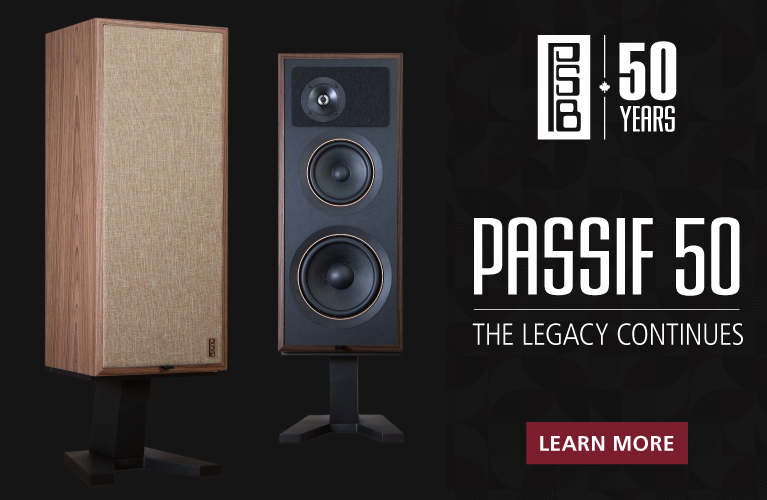From the late 1990s to the early 2000s, Montreal’s annual Salon Son & Image (SSI) was my favorite hi-fi show. There were always plenty of exhibitors and thousands of visitors -- a combination that made the event bristle with excitement. Nor did it hurt that Montreal is a great place to visit. I loved going there each spring.
Unfortunately for SSI, and for every other hi-fi show in the world, Munich’s annual High End show came along. It has grown and grown, and somewhere around 2014 it became the high-end audio event to attend, overtaking even the Consumer Electronics Show, held each year in Las Vegas, Nevada. So High End became my favorite show -- for the sheer number of exhibitors, for the huge numbers of new products introduced, and because, like Montreal, Munich is a fabulous place to visit.
Five years ago, SSI almost disappeared for good. Its owners, Michel Plante and Sarah Tremblay, sold it to the UK’s Chester Group, an organization notorious for its subpar promotion of the shows it owns. In no time, Chester had run SSI so far into the ground that they canceled the 2016 event only weeks before its scheduled opening day, leaving everyone hanging.
Plante and Tremblay, with some industry help, jumped back in, and put on the show regardless. That 2016 event ended up being smaller than usual, but was considered a success, given the circumstances -- no one had expected it to happen at all, especially on two weeks’ notice. In 2017, Plante and Tremblay put on another show, this time more successfully -- most attendees felt it was back to pre-Chester Group standards. They also gave it a new name: the Montreal Audio Fest. From what I saw at the 2018 event, the name is apt -- this show felt fresh and alive.

Montreal Audio Fest 2018 (March 23-25), which Jason Thorpe and I covered for SoundStage! Global, was the best Montreal audio show in almost ten years, with more exhibitors and attendees than I’d ever seen during that decade, and a surprisingly high number of new products introduced. Of these new products, I’ve chosen five as “The Best of Montreal Audio Fest 2018.” Four of my five picks are loudspeakers, and there’s a good reason: Most of the new products introduced were speakers. All prices are in Canadian dollars, except as noted.
Oracle Delphi Mk.VI Signature turntable
Oracle’s Delphi Mk.VI Signature turntable is my top pick mostly because its ancestor, the Delphi (1979), is my favorite hi-fi component of all time.
Although the original Delphi’s sound quality won it many awards, it was its stunning visual beauty that has made it, for me, a timeless classic. Despite being almost 40 years old, the original would earn accolades today. That’s also why, even though the last four decades have seen many changes in the Delphi to improve its performance, its original look has remained -- you don’t mess with success. At MAF 2018, I talked with Oracle’s current product designer, Jacques Riendeau, brother of founder Marcel Riendeau. Jacques told me that Marcel has an eye for detail and proportion that few others have. I agree, and there’s no better evidence than the original Delphi.
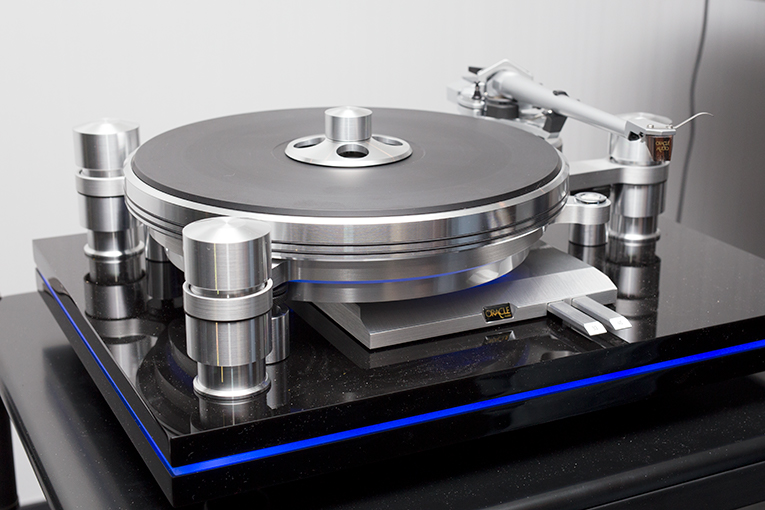
As for the Mk.VI Signature, Oracle has replaced the clear acrylic base of the Mk.VI Classic (still available) with a multilayer acrylic and an illuminated, colored centerpiece, similar to that of their Origine turntable, and to the Mk.VI Reference, which has a base of solid granite. The rest remains the same. You now have a choice of three Delphi Mk.VI beauties: the Signature ($24,700 for the full bundle, including SME’s V tonearm and Oracle’s Corinth cartridge), the Reference ($22,900), or the Classic ($21,200).
Muraudio SP1 loudspeaker
Few loudspeaker makers today think outside the box -- literally. Most speakers have two or more dynamic drivers -- conventional tweeters, midranges, woofers -- mounted on the front of a rectangular box, usually made of fiberboard. There might be a slight curvature of the side panels and/or an angled top panel, but most speakers are cut from the same cloth.
But in 2013, when the Canadian manufacturer Muraudio introduced the Domain Omni PX1, they proved that they could think outside the typical speaker box. The hybrid Domain Omni PX1 comprised three electrostatic panels, each curved horizontally and vertically (this had never been done before), to reproduce frequencies above 450Hz, all mated to three 9” woofers for everything below that. These panels and cones were aligned in a circular fashion to horizontally disperse their wavefronts omnidirectionally -- that is, through a full 360°. Muraudio made quite a statement with the PX1 -- but at $63,000 USD/pair, the Domain Omni PX1 was far beyond the reach of most audiophiles. (Last summer, the base price of the PX1 was reduced to $32,800 USD/pair.)
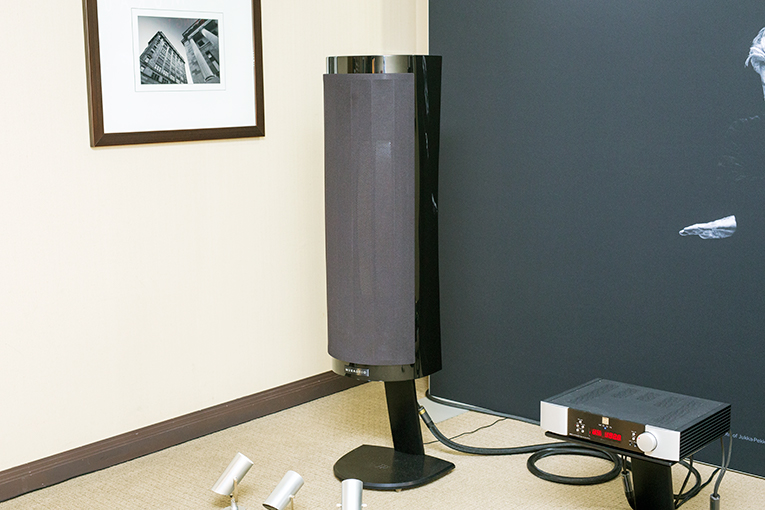
Enter another hybrid, the Muraudio SP1, which combines a single electrostatic panel, again horizontally and vertically curved, mounted at the center of a very curvaceous, open-backed, wooden cabinet, with four forward-firing 6” midrange-woofer cones -- two above and two below the ESL panel, each cone angled slightly outward. Unlike the 450Hz crossover in the PX1, the SP1’s midrange-woofers are crossed over to the ESL at 750Hz. According to designer Murray Harman, the design and configuration of these five drivers produce a near-perfect blend of their outputs, with wide, even dispersion across the speaker’s curved front surface. And because the cabinet is open-backed, the ESL panel acts as a dipole driver, directing as much energy rearward as forward, but out of phase -- you still get much of the spacious sound the PX1 is known for.
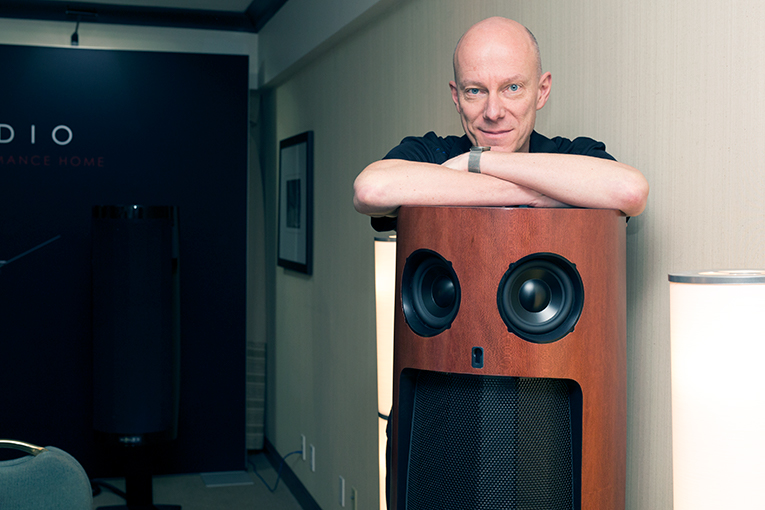 Murray Harman with a grilleless SP1
Murray Harman with a grilleless SP1
Two big bonuses: The SP1 costs only $14,700 USD/pair in a standard finish and requires much less power than the PX1. Whereas the PX1 needs at least 300Wpc into its impedance of 8 ohms, at MAF 2018 the SP1 (also 8 ohms) ran comfortably powered only by the 100Wpc of a Simaudio Moon Neo 340i integrated amplifier. What I heard in Montreal indicated real promise, but that’s all I’ll say for now -- by the time you read this, a pair of Muraudio SP1s will be set up in my room, and I’ll be listening to them for a forthcoming review.
Elac Debut 2.0 B6.2 loudspeaker
After we’d listened to the late John Campbell’s recording of “Down in the Hole,” a song composed and originally recorded by Tom Waits, Jason Thorpe turned to me and said, “That sounds like a whole lot more speaker than 450 bucks.” He was talking about the new Elac Debut 2.0 B6.2 ($449.98/pair), which, with a 1” tweeter, a 6.5” woofer, a 2.2kHz crossover frequency, and a cabinet of vinyl-clad wood, seems pretty damned ordinary. But it didn’t sound ordinary, and I think a lot of that had to do with who designed it and the other speakers comprising Elac’s Debut 2.0 line: Andrew Jones, first recognized for his high-priced, cutting-edge speaker designs for KEF and Technical Audio Devices (TAD), and now better known for his affordable designs for former employer Pioneer and current employer Elac Electroacoustic GmbH.
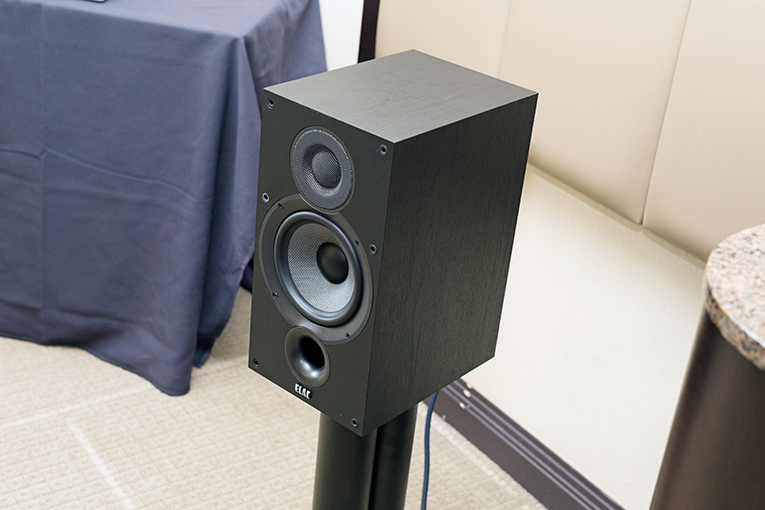
I, too, was taken by the Debut 2.0 B6.2, and really liked that, in Montreal, Elac was driving the pair of them with its own EA101EQ-G integrated amplifier. The EA101EQ-G ($999.98) includes a built-in, 24-bit/192kHz USB DAC, and is specified to output 40Wpc into 8 ohms or 80Wpc into 4 ohms. Elac’s system also included their DS-S101-G music server, which, at $1599.98, costs about the same as the integrated and speakers combined -- but someone using a computer as a source via the EA101EQ-G USB input, and some decent but cheap speaker cables, can have really good sound for a sensible price. To me, products such as the 2.0 B6.2 and EA101EQ-G are as important to hi-fi as any multi-thousand-dollar speaker or amplifier -- they’re not only the only sorts of components most people can afford, they’re what most people, regardless of income, are actually willing to pay for hi-fi gear. Good for Elac -- I hope they sell tons of Debut 2.0 B6.2s.
Paradigm Monitor SE Atom loudspeaker
Speaking of price, after Paradigm introduced their Prestige series, which topped out at the 95F ($5500/pair), they introduced the Persona line, which cost even more -- the flagship Persona 9H comes in at $38,000/pair. So when I walked into their room at MAF 2018 and saw a pair of Persona 3Fs ($12,000/pair) playing, I couldn’t help but wonder -- and worry -- if everyone at Paradigm had forgotten their roots as the budget leader, known for speakers priced more in the territory of Elac’s Debut 2.0 B6.2.
Thankfully, they haven’t. On one side of the room were two floorstanding speakers, and on the other two bookshelf models, all from their entry-level Monitor SE line, and a new series, Premier, which slots in just below the Prestige models. None of these was playing, but each model was interesting in its own way, and very affordably priced for what it appeared to offer. It was the smallest and cheapest that caught my eye and most piqued my interest: the Monitor SE Atom ($358/pair). The others are the Monitor SE 6000F ($1098/pair), the Premier 200B ($1098/pair), and the Premier 800F ($2490/pair).
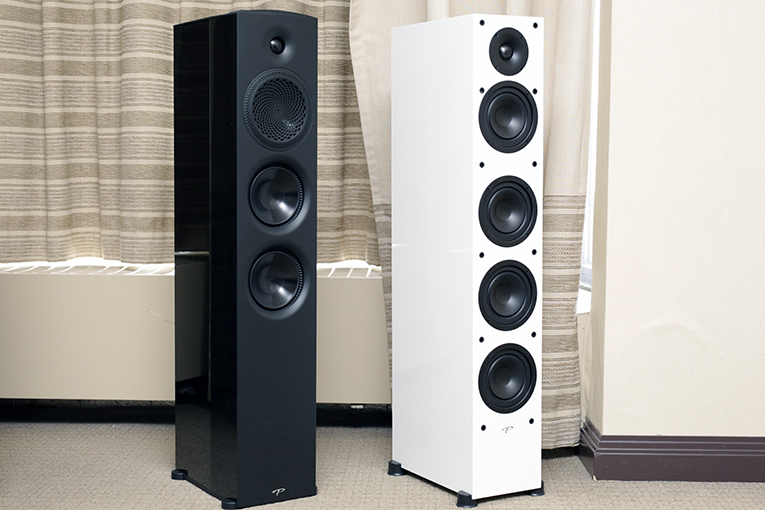 Premier 800F and Monitor SE 6000F
Premier 800F and Monitor SE 6000F
Why the Monitor SE Atom? Since 1992 -- longer than the SoundStage! Network has existed (we began in 1995) -- the original Atom and its subsequent iterations have serially acted as the gateway model to Paradigm’s product line. The Atom is also probably the highest-value speaker Paradigm has ever made -- which says a lot, given how many high-value models they’ve made. The fact that Paradigm has kept the Atom and the entire Monitor series alive, and at very affordable prices, means they haven’t forgotten their roots after all.
 Monitor SE Atom and Premier 200B
Monitor SE Atom and Premier 200B
The Monitor SE Atom measures 12.75”H x 7.125”W x 11”D and is, like every Atom before it, a two-way design. Whereas older Atoms were offered in a wood-like vinyl veneer, matte finishes of black or white are what are offered nowadays, and I think they look better, more modern. The Monitor SE Atom has a 1” S-PAL tweeter, crossed over at 2.3kHz to a 5.5” midrange-woofer with a mineral-filled polypropylene cone. The tweeter has a waveguide, and includes a unique Paradigm technology pioneered for the Prestige series: a Perforated Phase-Aligning (PPA) lens, which works to improve dispersion by blocking out-of-phase soundwaves and letting through only in-phase ones. (We produced a video about this technology in March 2017.) The woofer has an inverted dustcap and a surround that’s rolled inward, not outward. Although I can’t tell you what the Monitor SE Atom sounds like, I can tell you that a pair of review samples is on its way to the SoundStage! Network for review. Let’s see if this new Atom lives up to the legend of its ancestors.
Monitor Audio Studio loudspeaker
The trend toward high-quality sound at very reasonable prices continues with the stand-mounted Studio loudspeaker from Monitor Audio, the British speaker maker best known for (from entry to flagship level) their Bronze, Silver, Gold, and Platinum lines. Priced at $1800/pair, and available in satin finishes of black, white, or gray, the Studio is a different sort of model from Monitor: It’s not a member of any of the lines just mentioned, though Monitor says that its driver technology is borrowed from the Platinum models.
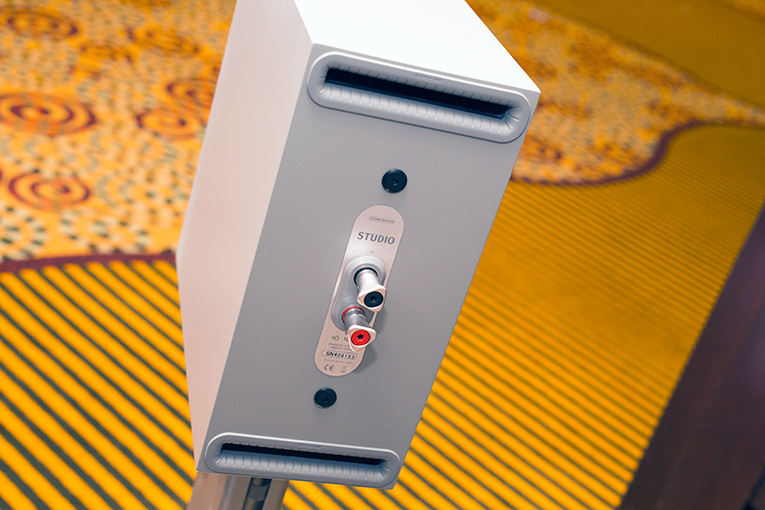
The Studio has two 4” midrange-woofers, one above and one below Monitor’s tweeter, a Micro Pleated Diaphragm (MPD) air-motion transformer (AMT). Monitor first used AMTs in the Platinum series -- it’s nice to see these drivers trickled down to a much more affordable model. The midrange-woofers are modified versions of a driver used in the Platinum PL500 II ($28,995 USD/pair), Monitor’s flagship model. Unique to the Studio are its horizontal slot ports on the rear (one high, one low), and the vertical configuration of the binding posts. Measuring a compact 13.4”H x 6.15”W x 14.2”D, the entire speaker looks sleek and contemporary. A nice visual touch is a small badge, reading “Studio,” in the lower corner of the front baffle and wrapping around to the side panel. These badges appear on opposite corners of the left and right speakers -- in that respect only, the Studio is sold in mirror-imaged pairs.
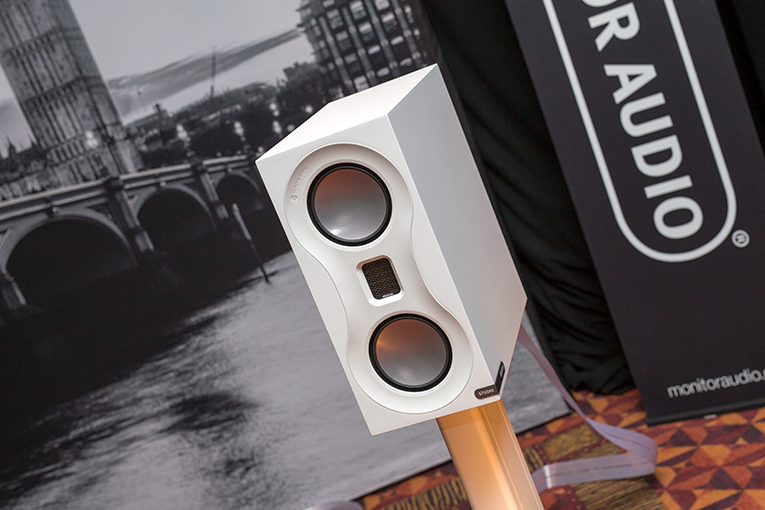
Besides looking great, the white pair of Studio Monitors playing sounded very good in their room (in front of the speakers were electronics from Roksan, a brand bought by Monitor Audio last year). But as with the Muraudio and Paradigm speakers above, the real assessment has yet to begin -- a review pair of Monitor Studios will be sent to us soon.
Next stop -- Munich
The 2018 show was the best Montreal Audio Fest or Salon Son & Image in years, and I have every reason to believe that the 2019 edition will be even better. Canadian audiophiles owe Michel Plante and Sarah Tremblay a debt of gratitude for keeping this wonderful show alive -- without them, I doubt anyone would have seen the shows of 2016, 2017, or 2018, let alone future MAFs.
But now my thoughts turn to Munich and High End, another show that keeps getting better -- and bigger -- each year. High End 2018 will be held May 10-13. We’ll be sending our biggest team yet to report on it as it happens. During the show we’ll post their coverage daily on SoundStage! Global, and follow it on June 1 with my “Best of High End 2018,” in this space.
. . . Doug Schneider
das@soundstagenetwork.com






















